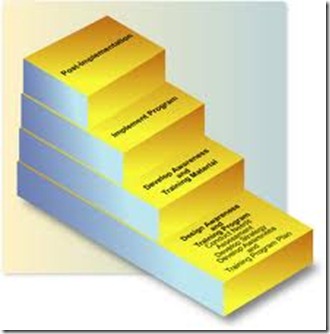Program Design and Implementation
TOP-DOWN DESIGN
Usually a top-down method is used for designing and writing a program. in top-down design
the main function of a program is expressed as simply as possible. This function is then split
up into more detailed separate procedures. These are then further split and so on. The process
finishes when the program has been split down to the level of the separate statements of the computer language being used.
The process of dividing parts of a program into gradually more detailed parts is called
stepwise refinement.
Simple example of stepwise refinement
Program function: input three numbers and print out their average.
First level of refinement:
(a) Input three numbers
(b) Calculate total and average
(c) Print numbers and their average
Second level of refinement:
In this simple example the next level would be separate program statements.
A program for the above example is written below in the language Pascal. Note that in Pascal:
1 Statements end with a semi-colon.
2 All variables used in a program have to be declared first in a V AR statement.
3 The first level of refinement is shown at the end of the program, after the final BEGIN
statement.
If you are not familiar with Pascal you may find COMAL easier to understand. The same
program has been written in COMAL
PROGRAM Average_Three_Numbers;
(*input three numbers and printout their average*)
VAR
Num1, Num2,Num3, Total, Average: REAL;
PROCEDURE input_Three_Numbers;
BEGIN
WRITELN (The Average of Three Numbers’);
WRITELN;
WRITE (‘Please type your first number ‘); READ (Num1);
WRITE (‘Please type your Second number ‘); READ (Num2);
WRITE (‘Please type your third number ‘); READ (Num3);
END;
PROCEDURE (Calculate-total-and-Average;
BEGIN
Total :=Num1+Num2+Num3;
Average:=total/3
End;
PROCEDURE (print-numbers-and-Average ;
BEGIN
WRITELN (The Numbers are: -‘ ,Numl,Num2,Num3);
WRITELN (‘Their average is : -‘ .Average);
END;
BEGIN
Input_ Three_Numbers:
Celculate_ Totalcand_Average:
Print_Numbers_and_Average;
END.
STEPS IN PRODUCING A PROGRAM
If it is decided that the solution of a problem requires a new program then the main steps
followed are:
1 Program design.
2 Program writing.
3 Testing and debugging.
4 Documentation, implementation and maintenance.
Program design
1 Function definition
The general system design is used to decide precisely what the program is to do. This design
may be in the form of system flowcharts. In any case it is necessary to define:
(a) The data requirements of the program-inputs, outputs and files.
(b) The processing function-what the program is to do with the data.
2 First level of refinement
(a) The data to be used is defined in detail. This includes arrays .
(b) The main operations of the program are defined-possibly using a structure diagram or an outline program flowchart .
Program writing
1Each operation is worked out in detail. If necessary this may be done using detailed
program flowcharts or structure diagrams.
2 The program is then coded. To code a program means to write it out in a suitable language.
3 The program is entered into a computer. (This may be done as the program is coded.)
Testing and debugging
1 If a compiler is used, errors are first eliminated which prevent the program from being
compiled .
2 Any further errors are eliminated which prevent the program from running.
3 The program is run with test data.
Test data is data which has been carefully chosen to tryout every feature of a program (or flowchart) to make sure that it carries out its intended function. It is important to make sure that:
(a) The test data provides a check on every possible situation.
(b) The correct results of running the program with the test data have been worked out
manually beforehand.
4 The programmer uses various debugging aids to correct the program until the expected output is produced when the test data is used .
Note: For a complex program it is very difficult to test every possible situation. Professional
programmers concentrate on designing and writing programs methodically so that they do not have errors.
1 The time saved in debugging is well worth the extra work in the early stages.
2 Programs with a lot of errors which need patching up are not as easy to read and to maintain
as those which are well written to start with. Examination candidates writing project programs would do well to note this.
Documentation, implementation and maintenance
1 Before a program can be made available for use it is necessary to produce documentation for users and programmers .
2 The new system of which the program forms part then has to be implemented and maintained .

